Introduction
The results reported in the July 2021 bank lending survey (BLS) relate to changes observed during the second quarter of 2021 and expectations for the third quarter of 2021. The survey was conducted between 14 and 29 June 2021. A total of 142 banks were surveyed in this round, with a response rate of 100%. In addition to results for the euro area as a whole, this report also contains results for the four largest euro area countries.[1]
A number of ad hoc questions were included in the July 2021 survey. They address the impact of the situation in financial markets on banks’ access to retail and wholesale funding, the impact of banks’ non-performing loan (NPL) ratios on their lending policies, the changes in bank lending conditions and loan demand across the main economic sectors, and the impact of government loan guarantees related to the coronavirus (COVID-19) pandemic on changes in banks’ lending conditions and demand for loans.
1 Overview of results
In the July 2021 survey round, euro area banks reported broadly unchanged credit standards on loans to enterprises and households in the second quarter of 2021 – i.e. the percentage of banks reporting a tightening of credit standards was almost identical to the percentage of banks reporting an easing of credit standards. These developments followed the significant net tightening of credit standards in 2020 and the moderate net tightening for loans to firms in the first quarter of 2021. They reflect the overall improvements seen in the euro area economy as containment measures are lifted and the continued support provided by monetary, fiscal and supervisory authorities. Fiscal support was also reflected in the net easing of credit standards on loans to firms with COVID-19-related government guarantees in the first half of 2021. The previous significant net tightening implied mainly by risk perceptions related to higher credit risks became smaller across loan categories: for loans to firms there was no further change to risk perceptions, while the previous net tightening of risk perceptions turned into a small net easing for housing loans. Banks’ cost of funds and balance sheet situation mostly had a neutral impact on credit standards, reflecting banks’ solid capital ratios and favourable funding costs. In the third quarter of 2021, euro area banks expect a slight net tightening of credit standards on loans to firms and broadly unchanged credit standards for loans to households.
On balance, banks reported an increase in demand for loans by firms and households in the second quarter of 2021. The net increase was moderate for loans to firms and strong for housing loans. The low general level of interest rates, supported by policy measures, continued to contribute to increasing loan demand by firms and households. In addition, financing needs for fixed investment had a positive impact on loan demand by firms for the first time since the third quarter of 2019, reflecting the improved economic outlook. For households, considerably higher consumer confidence, improved housing market prospects and increased spending on durable goods all supported loan demand. In the third quarter of 2021, banks expect a further net increase in demand for loans by both firms and households.
Looking at those developments in more detail, euro area banks reported broadly unchanged credit standards (i.e. banks’ internal guidelines or loan approval criteria) for loans or credit lines to enterprises in the second quarter of 2021 (with the net percentage of banks reporting a tightening of standards standing at -1%, down from 7% in the first quarter of 2021; see Section 2.1). This followed the significant net tightening of credit standards in the second half of 2020 and the moderate net tightening in the first quarter of 2021. Credit standards remained broadly unchanged for SMEs (-1%, down from 7%) and eased slightly for large firms (-3%, down from 5%). These developments reflect the overall improvements in the euro area economy, as suggested by recent business sentiment indicators such as the Purchasing Managers’ Index (PMI), and come in spite of more modest and volatile industrial production developments in the second quarter which are probably related to supply chain bottlenecks. In addition, the support provided by monetary, fiscal and supervisory authorities is helping to bridge the recovery phase and limit credit risks for banks. In the third quarter of 2021, euro area banks expect a slight net tightening of credit standards for loans to firms (2%).
On balance, banks reported unchanged risk perceptions in the second quarter of 2021, suggesting a stable assessment of credit risks, while banks’ risk tolerance continued to have a small net tightening impact. Following the considerable increase in risk perceptions in 2020 and a more moderate rise in the first quarter of 2021, banks assessed the risks in their corporate loan portfolios as being broadly stable in the second quarter of 2021 owing to the improved general economic situation and the likely recovery in firms’ revenues. At the same time, banks’ lower risk tolerance continued to have a small net tightening impact. Competition from other banks and market-based financing exerted a limited net easing impact on credit standards. In line with previous quarters, banks’ cost of funds and balance sheet situation had a broadly neutral impact on credit standards for loans to firms. Specifically, banks’ ample liquidity situation – partly related to the take-up in TLTRO III operations – is reflected in the easing impact that their liquidity position is having on credit standards for loans to firms.
In the second quarter of 2021, euro area banks reported broadly unchanged credit standards for housing loans (with the net percentage of banks standing at -1%, after -2% in the first quarter of 2021; see Section 2.2), as well as for consumer credit and other lending to households (0%, down from 5%). For housing loans, risk perceptions related to the improved economic outlook and competitive pressures from other banks had an easing impact on credit standards, while banks’ funding costs and balance sheet situations had a slight net tightening impact. Risk perceptions continued to have a moderate tightening impact on credit standards for consumer credit, while banks’ increased risk tolerance contributed to an easing. Banks expect credit standards to remain broadly unchanged for housing loans (1%) and consumer credit (-1%) in the third quarter.
Banks’ overall terms and conditions (i.e. the actual terms and conditions agreed in the loan contract) for new loans to enterprises eased in the second quarter of 2021 (net percentage of -5%, after 0%), mainly on account of competitive pressures. Margins on average loans (defined as the spread over relevant market reference rates) narrowed in net terms, while margins on riskier loans remained unchanged. Overall, margin developments were consistent with the recent favourable developments in firms’ borrowing costs, despite some volatility in bank lending rates. In addition, the net tightening of collateral requirements weakened considerably relative to the second half of 2020. Banks also reported, on balance, an easing of their overall terms and conditions for housing loans (net percentage of -3%, after -6%), as well as for consumer credit and other lending to households (-6%, after 0%).
In the second quarter of 2021, banks reported, on balance, that the share of rejected applications for loans to firms remained unchanged (with the net percentage standing at 0%, down from 8%), reflecting banks’ broadly unchanged loan approval criteria and the perception that credit risks of firms were broadly stable. For housing loans, euro area banks reported, on balance, an increase in the share of rejected applications (11%, up from -1%), possibly partly related to strong loan demand, while the share of rejected applications remained unchanged in net terms for consumer credit (0%, down from 7%).
Looking at the largest euro area countries, credit standards for loans to enterprises eased in Germany and remained unchanged in France, Spain and Italy in the second quarter of 2021 (see overview table). Credit standards for housing loans eased in Germany, remained unchanged in Spain and Italy, and tightened in France. Credit standards for consumer credit and other lending to households eased in Germany, while they remained unchanged in Spain, France and Italy.
Banks reported, on balance, a moderate increase in firms’ demand for loans in the second quarter of 2021 (with the net percentage standing at 8%, up from -15% in the first quarter of 2021; see Section 2.2), which was the first net increase in demand since the second quarter of 2020. Given the leading indicator properties of BLS loan demand for actual loan developments, this suggests an increase in realised loan flows in the coming months. For the first time since the third quarter of 2019, firms’ financing needs for fixed investment contributed positively to loan demand, suggesting that firms have become less reluctant to invest against the background of the improved economic outlook.[2] Banks also reported a considerable positive impact on loan demand from debt refinancing and restructuring (partly related to the adjustment of conditions for public loan guarantees) and from merger and acquisition (M&A) activity. By contrast, their financing needs for working capital remained unchanged against the background of available liquidity buffers and the likely recovery in revenues given the improving economic situation. The latter is also reflected in the dampening impact of firms’ internal financing on loan demand. In the third quarter of 2021, banks expect a stronger net increase in firms’ demand for loans (net percentage of 31%).
Banks reported, on balance, a strong increase in demand for housing loans in the second quarter of 2021 (net percentage of 36%, up from -7% in the first quarter of 2021; see Section 2.2), as well as a more limited net increase in demand for consumer credit (net percentage of 11%, up from -19%; see overview table). These developments were broadly in line with the strong actual growth in loans to households for house purchases and the slight increase in consumer credit. The net increase in demand for loans to households was linked to considerably higher consumer confidence (the first time this had been seen since the start of the pandemic crisis), as well as the low general level of interest rates. In addition, housing market prospects contributed positively to demand for housing loans, while increased spending on durables contributed positively to demand for consumer credit, probably reflecting the improved economic outlook. Banks expect a further net increase in demand for housing loans (12%) and a larger net increase for consumer credit (31%) in the third quarter of 2021.
Banks reported, on balance, an increase in demand for loans to enterprises in France and Spain, while such demand remained unchanged in Germany and Italy in the second quarter of 2021. Net demand for housing loans increased in all four of the largest euro area countries. For consumer credit, demand increased on balance in Germany, Spain and Italy, while it declined in France.
Overview table
Latest BLS results for the largest euro area countries
(net percentages of banks reporting a tightening of credit standards or an increase in loan demand)
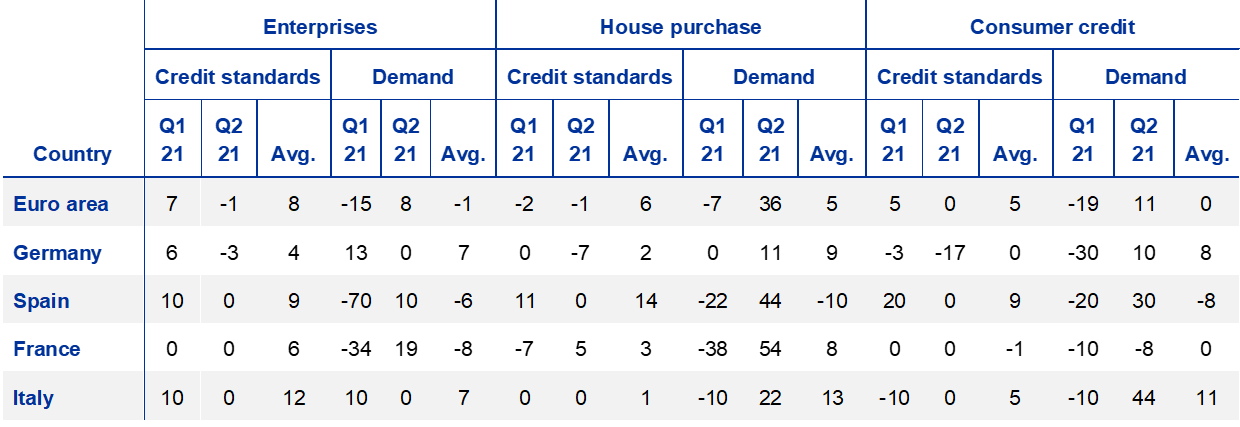
Notes: The “Avg.” columns contain historical averages, which are calculated over the period since the beginning of the survey, excluding the most recent round. For France, net percentages are weighted on the basis of outstanding loan amounts for individual banks in the respective national samples. Owing to the different sample sizes across countries, which broadly reflect the differences in the national shares in lending to the euro area non-financial private sector, the size and volatility of the net percentages cannot be directly compared across countries.
The July 2021 BLS also included a number of ad hoc questions. As regards euro area banks’ access to retail and wholesale funding, banks reported, on balance, that such access continued to improve in the second quarter of 2021. The net improvement was strongest for debt securities and more limited for securitisation.
Euro area banks’ non-performing loan (NPL) ratios had a moderate net tightening impact on credit standards for loans to enterprises and a broadly neutral impact on credit standards for loans to households in the first half of 2021. Over the next six months, banks expect a smaller net tightening impact on lending conditions for loans to enterprises and a broadly neutral impact for households. This suggests that banks do not foresee an increase in their NPL ratios that is severe enough to considerably affect their lending conditions, despite remaining uncertainty about the latent credit risks of their borrowers. Risk perceptions related to the general economic outlook and borrowers’ creditworthiness, as well as lower risk tolerance, were the main drivers of the net tightening impact of NPL ratios.
Euro area banks reported a moderate net tightening of credit standards for new loans to enterprises across the main economic sectors in the first half of 2021. This is in line with the moderate net tightening reported by banks for loans to all firms in the first quarter of 2021 and the broadly unchanged credit standards in the second quarter. Over the next six months, banks expect heterogeneous developments in lending conditions across sectors, but changes are expected to be moderate in both directions. Banks reported, on balance, an increase in demand for loans or credit lines in nearly all of the main economic sectors with the exception of commercial real estate, where net demand remained unchanged in the first half of 2021. Over the next six months, euro area banks expect a further – and larger – net increase in demand by firms across all of the main economic sectors.
Euro area banks reported that COVID-19-related government guarantees continued to support banks’ lending conditions for loans to firms, while demand for loans with guarantees declined in net terms in the first half of 2021. Credit standards and overall terms and conditions for loans to firms with COVID-19-related government guarantees continued to ease. Over the next six months, banks expect a small further net easing of credit standards and terms and conditions for these loans. Demand for loans both with and without COVID-19-related government guarantees declined on balance in the first half of 2021, reflecting the moderation of realised loan flows after the significant take-up of guaranteed loans in 2020. Over the next six months, euro area banks expect a further net decline in demand for loans with guarantees, but a net increase in demand for loans without guarantees, as the economic recovery progresses.
Box 1
General notes
The bank lending survey (BLS) is addressed to senior loan officers at a representative sample of euro area banks. In the current round, 142 banks were surveyed, representing all euro area countries and reflecting the characteristics of their respective national banking structures. The main purpose of the BLS is to enhance the Eurosystem’s knowledge of bank lending conditions in the euro area.[3]
BLS questionnaire
The BLS questionnaire contains 22 standard questions on past and expected future developments: 18 backward-looking questions and four forward-looking questions. In addition, it contains one open-ended question. Those questions focus on developments in loans to euro area residents (i.e. domestic and euro area cross-border loans) and distinguish between three loan categories: loans or credit lines to enterprises; loans to households for house purchase; and consumer credit and other lending to households. For all three categories, questions are asked about the credit standards applied to the approval of loans, the terms and conditions of new loans, loan demand, the factors affecting loan supply and demand conditions, and the percentage of loan applications that are rejected. Survey questions are generally phrased in terms of changes over the past three months or expected changes over the next three months. Survey participants are asked to indicate in a qualitative way the strength of any tightening or easing or the strength of any decrease or increase, reporting changes using the following five-point scale: (1) tightened/decreased considerably, (2) tightened/decreased somewhat, (3) basically no change, (4) eased/increased somewhat or (5) eased/increased considerably.
In addition to the standard questions, the BLS questionnaire may contain ad hoc questions on specific topics of interest. Whereas the standard questions cover a three-month time period, the ad hoc questions tend to refer to changes over a longer time period (e.g. over the past and next six months).
Aggregation of banks’ replies to national and euro area BLS results
The responses of the individual banks participating in the BLS are aggregated in two steps. In the first step, the responses of individual banks are aggregated to form national results for euro area countries. And in the second step, those national BLS results are aggregated to form euro area BLS results.
In the first step, banks’ replies can be aggregated to form national BLS results by applying equal weights to all banks in the sample[4] or, alternatively, by applying a weighting scheme based on outstanding loans to non-financial corporations and households for the individual banks in the respective national samples. For France, Malta, the Netherlands and Slovakia, an explicit weighting scheme is applied.
In the second step, since the numbers of banks in the national samples differ considerably and do not always reflect those countries’ respective shares of lending to euro area non-financial corporations and households, the national survey results are aggregated to form euro area BLS results by applying a weighting scheme based on national shares of outstanding loans to euro area non-financial corporations and households.
BLS indicators
Responses to questions relating to credit standards are analysed in this report by looking at the difference (the “net percentage”) between the percentage of banks reporting that credit standards applied in the approval of loans have been tightened and the percentage of banks reporting that they have been eased. For all questions, the net percentage is determined on the basis of all participating banks that have business in or exposure to the respective loan categories (i.e. they are all included in the denominator when calculating the net percentage). This means that banks that specialise in certain loan categories (e.g. banks that only grant loans to enterprises) are only included in the aggregation for those categories. All other participating banks are included in the aggregation of all questions, even if a bank replies that a question is “not applicable” (“NA”). This harmonised aggregation method was introduced by the Eurosystem in the April 2018 BLS. It has been applied to all euro area and national BLS results in the current BLS questionnaire, including backdata.[5] The resulting revisions for the standard BLS questions have generally been small, but revisions for some ad hoc questions have been larger owing to a higher number of “not applicable” replies by banks.
A positive net percentage indicates that a larger proportion of banks have tightened credit standards (“net tightening”), whereas a negative net percentage indicates that a larger proportion of banks have eased credit standards (“net easing”).
Likewise, the term “net demand” refers to the difference between the percentage of banks reporting an increase in loan demand (i.e. an increase in bank loan financing needs) and the percentage of banks reporting a decline. Net demand will therefore be positive if a larger proportion of banks have reported an increase in loan demand, whereas negative net demand indicates that a larger proportion of banks have reported a decline in loan demand.
In the assessment of survey balances for the euro area, net percentages between -1 and +1 are generally referred to as “broadly unchanged”. For country results, net percentage changes are reported in a factual manner, as differing sample sizes across countries mean that the answers of individual banks have differing impacts on the magnitude of net percentage changes.
In addition to the “net percentage” indicator, the ECB also publishes an alternative measure of banks’ responses to questions relating to changes in credit standards and net demand. This measure is the weighted difference (“diffusion index”) between the percentage of banks reporting that credit standards have been tightened and the percentage of banks reporting that they have been eased. Likewise, as regards demand for loans, the diffusion index refers to the weighted difference between the percentage of banks reporting an increase in loan demand and the percentage of banks reporting a decline. The diffusion index is constructed in the following way: lenders who have answered “considerably” are given a weight (score of 1) which is twice as large as that given to lenders who have answered “somewhat” (score of 0.5). The interpretation of the diffusion indices follows the same logic as the interpretation of net percentages.
Detailed tables and charts based on the responses provided can be found in Annex 1 for the standard questions and Annex 2 for the ad hoc questions. In addition, BLS time series data are available on the ECB’s website via the Statistical Data Warehouse.
A copy of the questionnaire, a glossary of BLS terms and a BLS user guide with information on the BLS series keys can all be found on the ECB website.
2 Developments in credit standards, terms and conditions, and net demand for loans in the euro area
2.1 Loans to enterprises
2.1.1 Credit standards for loans to enterprises remained broadly unchanged
Euro area banks reported, on balance, broadly unchanged credit standards (i.e. banks’ internal guidelines or loan approval criteria) for loans or credit lines to enterprises in the second quarter of 2021 – i.e. the percentage of banks reporting a tightening of credit standards and the percentage of banks reporting an easing of standards were almost identical (net percentage of -1%, down from 7% in the first quarter of 2021; see Chart 1 and overview table). That net percentage was below banks’ expectations in the previous quarter (5%) and also below the historical average since 2003 (8%). At the same time, it followed the significant net tightening of credit standards for loans to firms in the second half of 2020 and the moderate net tightening in the first quarter of 2021.[6] The broadly unchanged credit standards reflect the overall improvement in the euro area economy, as also suggested by recent business sentiment indicators such as the PMI, and come in spite of more modest and volatile industrial production developments in the second quarter which are probably related to supply chain bottlenecks. In addition, the support by monetary, fiscal and supervisory authorities is helping to bridge the recovery phase and limit credit risks for banks. Credit standards remained broadly unchanged for SMEs (-1%, down from 7%), and eased slightly for large firms (-3%, down from 5%). The favourable developments across firm sizes, despite SMEs’ typically higher credit risks owing to their potentially opaque balance sheets, show the beneficial impact of public support measures (especially for SMEs). Credit standards eased slightly for short-term loans (-2%, after 6%) and remained unchanged for long-term loans (0%, after 10%).
On balance, banks reported unchanged risk perceptions in the second quarter of 2021, suggesting a stable assessment of credit risks, while banks’ risk tolerance continued to have a small net tightening impact (see Chart 1 and Table 1). Following the considerable net increase in risk perceptions in 2020 and the more moderate rise in the first quarter of 2021, banks assessed the risks in their corporate loan portfolios as being broadly stable in the second quarter owing to the improved general economic situation and the likely recovery in firms’ revenues. While firms’ gross debt ratios remain high overall, the economic recovery and the lower emergency financing needs as firm revenues recover will tend to provide relief to firms’ debt ratios and stabilise credit risks. At the same time, banks’ lower risk tolerance continued to have a small net tightening impact in the second quarter. Competition exerted a limited net easing impact on credit standards – both competition from other banks and competition from market-based financing (with the latter reflecting favourable market financing conditions for corporations). In line with previous quarters, banks’ cost of funds and balance sheet situations continued, overall, to have a broadly neutral impact on credit standards for loans to firms. Banks’ solid capital ratios and continued favourable funding costs were reflected, in net terms, in the broadly neutral impact of banks’ capital positions and market financing conditions, while banks’ ample liquidity holdings – partly related to the take-up in TLTRO III operations – were reflected in the small additional net easing impact that their liquidity positions had on credit standards.
Chart 1
Changes in credit standards applied to the approval of loans or credit lines to enterprises, and contributing factors
(net percentages of banks reporting a tightening of credit standards and contributing factors)
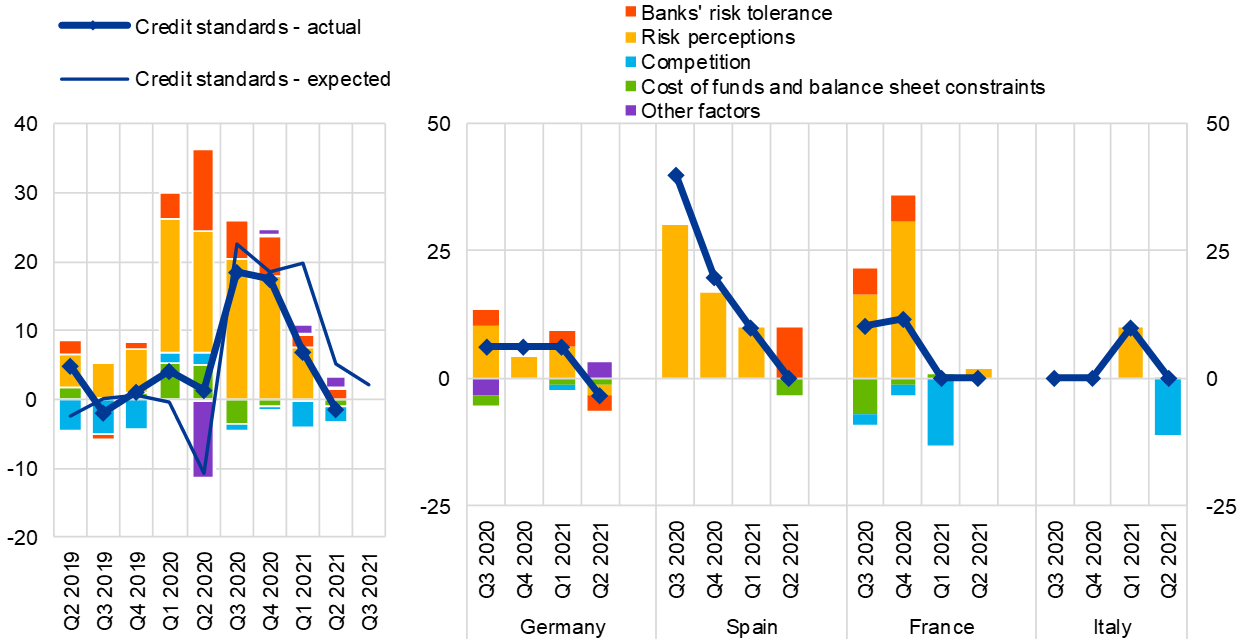
Notes: “Actual” values are changes that have occurred, while “expected” values are changes anticipated by banks. Net percentages are defined as the difference between the sum of the percentages of banks responding “tightened considerably” and “tightened somewhat” and the sum of the percentages of banks responding “eased somewhat” and “eased considerably”. The net percentages for responses to questions related to contributing factors are defined as the difference between the percentage of banks reporting that the given factor contributed to a tightening and the percentage reporting that it contributed to an easing. “Cost of funds and balance sheet constraints” is the unweighted average of “costs related to capital position”, “access to market financing” and “liquidity position”; “risk perceptions” is the unweighted average of “general economic situation and outlook”, “industry or firm-specific situation and outlook/borrower’s creditworthiness” and “risk related to the collateral demanded”; “competition” is the unweighted average of “competition from other banks”, “competition from non-banks” and “competition from market financing”. The net percentages for “other factors” refer to further factors which were mentioned by banks as having contributed to changes in credit standards, currently mainly related to the policy interventions in response to the COVID-19 pandemic.
Table 1
Factors contributing to changes in credit standards for loans or credit lines to enterprises
(net percentages of banks)

Note: See the notes on Chart 1.
Looking at the largest euro area countries, credit standards for loans to enterprises eased in Germany and remained unchanged in France, Spain and Italy in the second quarter of 2021. Notable developments were a net easing impact of competitive pressure in Italy and a net tightening impact of banks’ risk tolerance in Spain, compared with a small net easing impact of risk perceptions and risk tolerance in Germany.
In the third quarter of 2021, euro area banks expect a slight net tightening of credit standards for loans to firms (net percentage of 2%). This confirms that banks do not expect a considerable deterioration in their credit supply. Overall, based on the leading indicator properties of BLS credit standards for loan developments, current BLS developments do not signal a sharp reduction in lending to firms in the coming quarters.
2.1.2 Terms and conditions on loans to enterprises eased
Banks’ overall terms and conditions (i.e. the actual terms and conditions agreed in the loan contract) for new loans to enterprises eased in the second quarter of 2021 (net percentage of -5%, after 0%; see Chart 2 and Table 2). Margins on average loans (defined as the spread over relevant market reference rates) narrowed in net terms according to euro area banks, while margins on riskier loans remained unchanged. Margin developments are, overall, consistent with the recent favourable developments in firms’ borrowing costs, despite some volatility in bank lending rates. The net tightening of collateral requirements became considerably weaker relative to the second half of 2020. In addition, longer maturities and larger loan sizes contributed to an easing of terms and conditions for loans to firms (included in “other terms and conditions”).
Competition, banks’ funding costs and balance sheet situations, and risk perceptions all had a net easing impact on banks’ overall terms and conditions, while banks’ risk tolerance had a small net tightening impact (see Table 3). Competition was the main driver of the net easing of banks’ overall terms and conditions in the second quarter of 2021. This may be partly related to the attractive funding conditions of TLTRO III operations, which banks are passing on to borrowers, putting competitive pressure on other banks which are aiming to keep their market shares. Related to this, favourable bank funding costs also had a net easing impact on overall terms and conditions for loans to firms, as did risk perceptions. By contrast, banks’ risk tolerance had a small net tightening effect on banks’ overall terms and conditions.
Chart 2
Changes in terms and conditions on loans or credit lines to enterprises
(net percentages of banks reporting a tightening of terms and conditions)
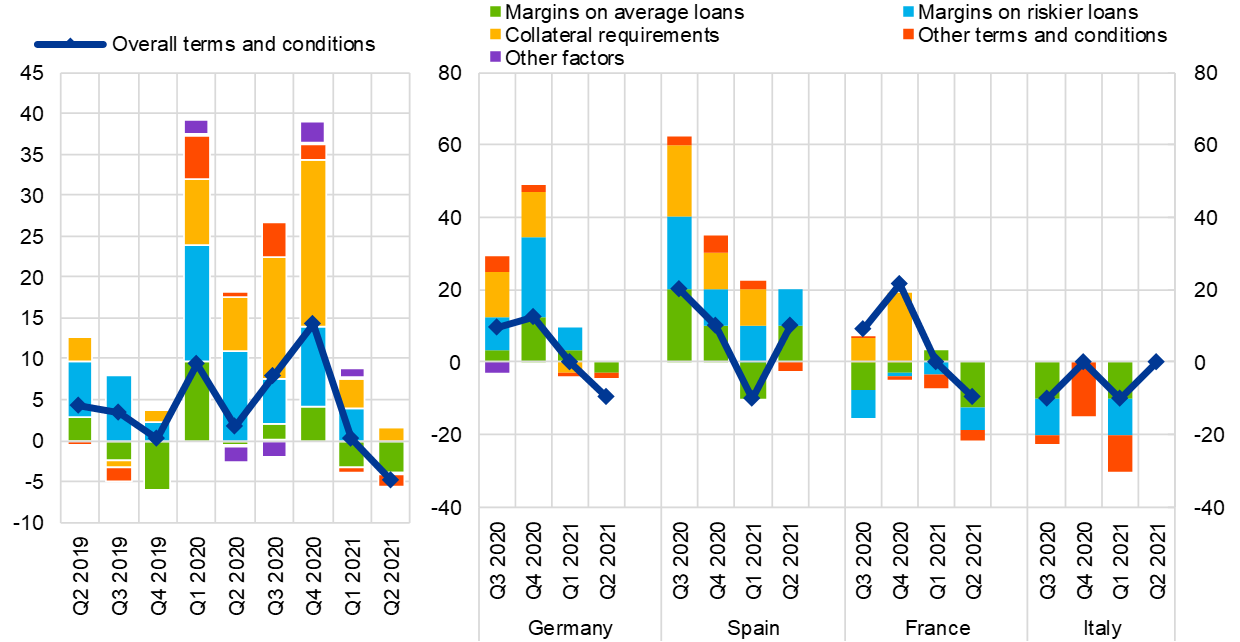
Notes: “Margins” are defined as the spread over a relevant market reference rate. “Other terms and conditions” is the unweighted average of “non-interest rate charges”, “size of the loan or credit line”, “loan covenants” and “maturity”. The net percentages for “other factors” refer to further factors which were mentioned by banks as having contributed to changes in terms and conditions.
Table 2
Changes in terms and conditions on loans or credit lines to enterprises
(net percentages of banks)

Note: See the notes on Chart 2.
Looking at the largest euro area countries, overall terms and conditions on loans or credit lines to enterprises eased on balance in Germany and France, while they tightened in Spain (following an easing in the previous quarter) and remained unchanged in Italy. In both Germany and France, the net easing of terms and conditions was due to narrower margins on average loans and longer loan maturities. On top of that, the net easing of overall terms and conditions was also due to larger loan sizes in Germany, and due to narrower margins on riskier loans in France. In both countries, banks’ favourable funding costs and balance sheet situations contributed to the net easing of terms and conditions, and competition and lower risk perceptions also contributed in France. By contrast, the net tightening of overall terms and conditions in Spain was related to increases in loan margins, driven by lower risk tolerance, while the various components remained unchanged in Italy.
Table 3
Factors contributing to changes in overall terms and conditions on loans or credit lines to enterprises
(net percentages of banks)

Note: The net percentages for these questions relating to contributing factors are defined as the difference between the percentage of banks reporting that the given factor contributed to a tightening and the percentage reporting that it contributed to an easing.
2.1.3 Rejection rate for loans to enterprises remained unchanged
In the second quarter of 2021, euro area banks reported, on balance, that the share of rejected applications for loans to firms remained unchanged (net percentage of 0%, down from 8% in the previous quarter; see Chart 3). This development is consistent with banks’ broadly unchanged credit standards (which are set before loans are actually applied for and negotiated) and the perception that firms’ credit risks were broadly stable.
Despite the stability of the share of loan rejections at euro area level, banks in Germany, France and Italy reported, on balance, an increase in this share, while banks in Spain indicated that the situation was unchanged.[7]
Chart 3
Changes in the rejection rate for loans to enterprises
(net percentages of banks reporting an increase in the share of rejections)
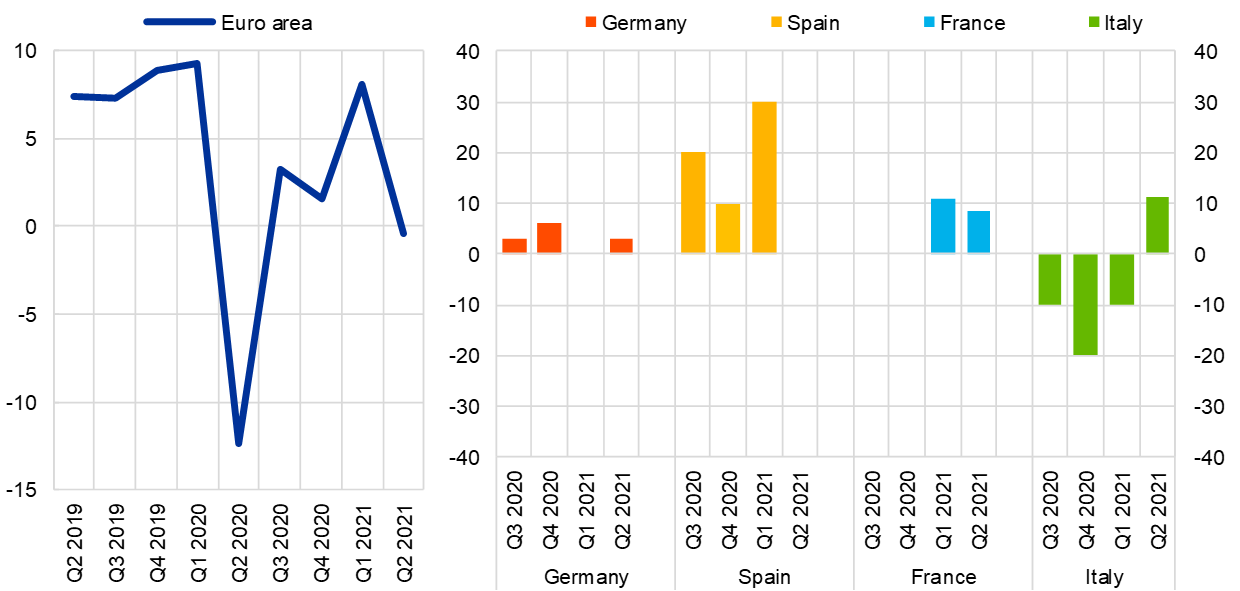
Notes: The net percentages for rejected loan applications are defined as the difference between the percentage of banks reporting an increase in the share of loan rejections and the percentage of banks reporting a decline. Banks’ responses refer to the share of rejected loan applications relative to the total volume of applications in that loan category.
2.1.4 Net demand for loans to enterprises increased moderately
Banks reported, on balance, a moderate increase in firms’ demand for loans or credit lines in the second quarter of 2021 (net percentage of banks at 8%, up from -15% in the first quarter of 2021[8]; see Chart 4 and overview table). This was the first net increase since the extraordinarily high loan demand seen in the second quarter of 2020. Given the leading indicator properties of BLS loan demand for growth in loans to firms, this suggests a potential increase in realised loan flows in the coming months. Banks reported net increases in loan demand for both SMEs (net percentage of 6%) and large firms (6%). While loan demand decreased on balance for short-term loans (-6%), it increased for long-term loans (10%), suggesting a shift towards longer maturities.
For the first time since the third quarter of 2019, firms’ financing needs for fixed investment contributed positively to loan demand (net percentage of 4%, up from -21% in the previous quarter) according to euro area banks (see Chart 4 and Table 4). This suggests that firms have become less reluctant to invest, against the background of the improved economic outlook as suggested by sentiment indicators such as the PMI and European Commission business and consumer survey results for the period from April to June 2021.[9] In addition, banks reported a considerable positive impact on loan demand from debt refinancing and restructuring, as well as M&A activity (included in “other financing needs”).[10] The former is partly related to changes in the conditions of public loan guarantees leading to refinancing with longer maturities, as well as the fact that the low interest rate environment more generally is providing incentives to shift to longer maturities. In addition, M&A activity and corporate restructuring, being supported by the low general level of interest rates, has also contributed positively to loan demand. Banks indicated, in net terms, that firms’ financing needs for working capital remained unchanged, in line with firms’ available liquidity buffers and the likely recovery in revenues. The latter is also reflected in the dampening impact of firms’ internal financing on loan demand. By contrast, looking at alternative external financing sources, issuance of corporate bonds had a broadly neutral impact on firms’ demand for bank loans and issuance of equity had a slightly positive impact according to euro area banks.
Chart 4
Changes in demand for loans or credit lines to enterprises, and contributing factors
(net percentages of banks reporting an increase in demand, and contributing factors)
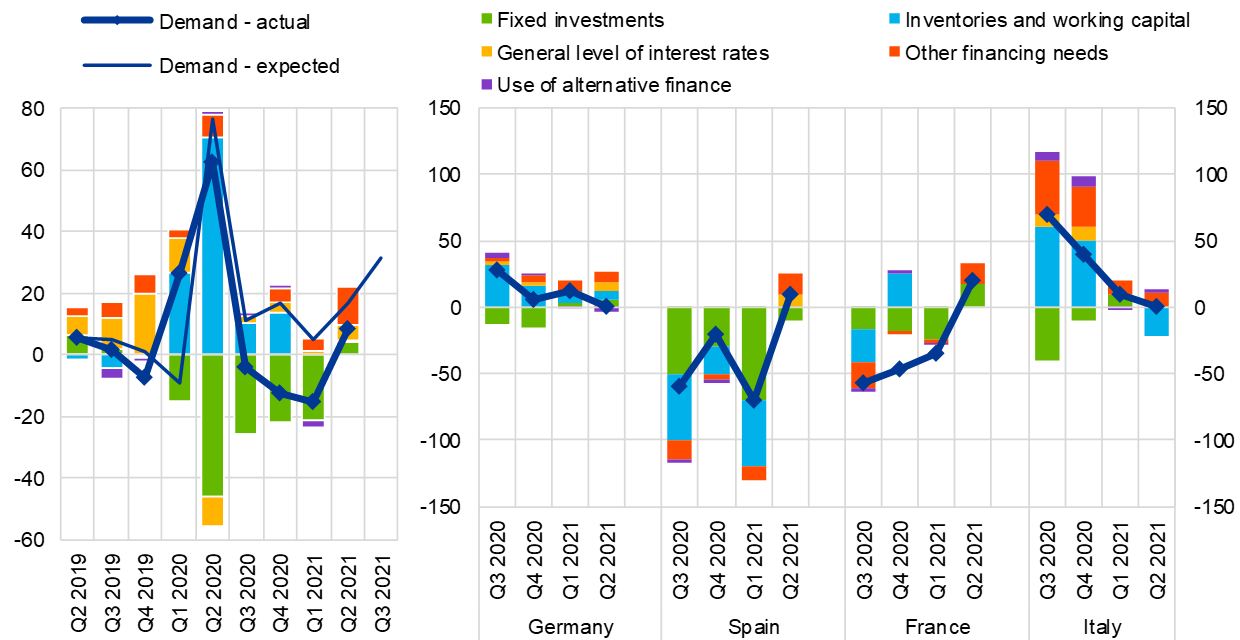
Notes: “Actual” values are changes that have occurred, while “expected” values are changes anticipated by banks. Net percentages for the questions on demand for loans are defined as the difference between the sum of the percentages of banks responding “increased considerably” and “increased somewhat” and the sum of the percentages of banks responding “decreased somewhat” and “decreased considerably”. The net percentages for responses to questions relating to contributing factors are defined as the difference between the percentage of banks reporting that the given factor contributed to increasing demand and the percentage reporting that it contributed to decreasing demand. “Other financing needs” is the unweighted average of “mergers/acquisitions and corporate restructuring” and “debt refinancing/restructuring and renegotiation”; “use of alternative finance” is the unweighted average of “internal financing”, “loans from other banks”, “loans from non-banks”, “issuance/redemption of debt securities” and “issuance/redemption of equity”.
Looking at the largest euro area countries, banks reported a net increase in firms’ demand for loans in France and Spain, while they reported unchanged loan demand on balance in Germany and Italy. Banks in Germany and France reported that fixed investment, M&A activity and corporate restructuring had a positive impact on financing needs, while loan demand in Spain and Italy was driven largely by debt refinancing and restructuring. In Spain, the considerably positive impact of debt refinancing and restructuring is related to an extension of the maturity of public loan guarantees, which led to shifts into longer maturities, as also reflected in actual loan flows in April and May. Internal financing dampened loan demand on balance in Germany and Spain, while banks in France and Italy reported a neutral impact.
In the third quarter of 2021, euro area banks expect a stronger net increase in firms’ demand for loans (net percentage of 31%) – especially for SMEs (net percentage of 35%, compared with 27% for large firms).
Table 4
Factors contributing to changes in demand for loans or credit lines to enterprises
(net percentages of banks)

Note: See the notes on Chart 4.
2.2 Loans to households for house purchase
2.2.1 Credit standards for loans to households for house purchase remained broadly unchanged
In the second quarter of 2021, euro area banks reported broadly unchanged credit standards for loans to households for house purchase (net percentage of banks at ‑1%, after -2% in the previous quarter; see Chart 5 and overview table), compared with a historical average of 6% since 2003. This suggests that euro area banks consider, on balance, that their loan approval criteria for housing loans are broadly appropriate given the economic situation and borrowers’ credit risks, following a stronger net tightening in 2020.
Risk perceptions related to the improved economic outlook and competitive pressures from other banks had an easing impact on credit standards. By contrast, banks’ funding costs and balance sheet situations had a slight net tightening impact (see Chart 5 and Table 5).
Looking at the largest euro area countries, credit standards for housing loans eased in Germany, tightened in France, and remained unchanged in Italy and Spain in the second quarter. The impact of the factors contributing to changes in credit standards was heterogeneous across the various countries. The improved economic outlook had an easing impact on credit standards for housing loans, especially in Germany and France. By contrast, banks’ lower risk tolerance had a net tightening effect on credit standards in Italy.
Looking ahead, euro area banks expect credit standards for housing loans to remain broadly unchanged (net percentage of 1%) in the third quarter of 2021.
Chart 5
Changes in credit standards applied to the approval of loans to households for house purchase, and contributing factors
(net percentages of banks reporting a tightening of credit standards, and contributing factors)
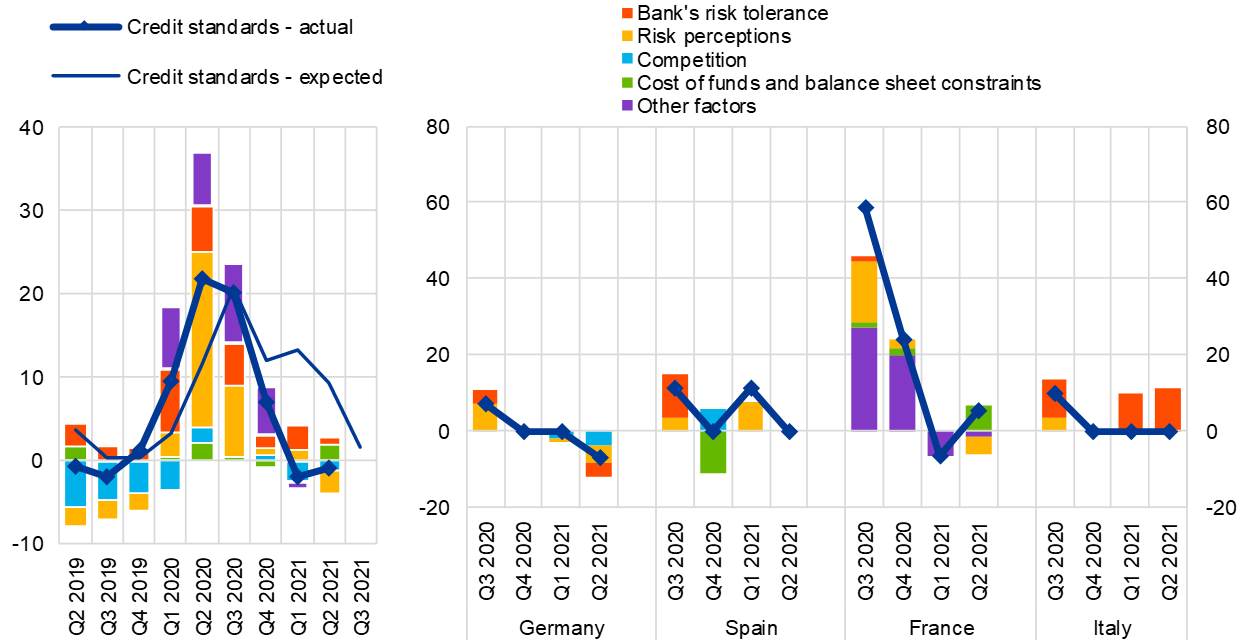
Notes: See the notes on Chart 1. “Risk perceptions” is the unweighted average of “general economic situation and outlook”, “housing market prospects, including expected house price developments” and “borrower’s creditworthiness”; “competition” is the unweighted average of “competition from other banks” and “competition from non-banks”. The net percentages for “other factors” refer to further factors which were mentioned by banks as having contributed to changes in credit standards, currently mainly related to macroprudential policy recommendations.
Table 5
Factors contributing to changes in credit standards for loans to households for house purchase
(net percentages of banks)

Note: See the notes on Chart 5.
2.2.2 Terms and conditions on loans to households for house purchase eased
Banks reported, on balance, an easing of overall terms and conditions for housing loans (net percentage of -3%, after -6% in the previous quarter). The net easing was mainly related to a narrowing of margins on average loans, while margins on riskier loans and collateral requirements remained broadly unchanged (see Chart 6 and Table 6). In addition, loan maturities and loan-to-value ratios had a net tightening impact, mainly owing to developments in France.
Chart 6
Changes in terms and conditions on loans to households for house purchase
(net percentages of banks reporting a tightening of terms and conditions)
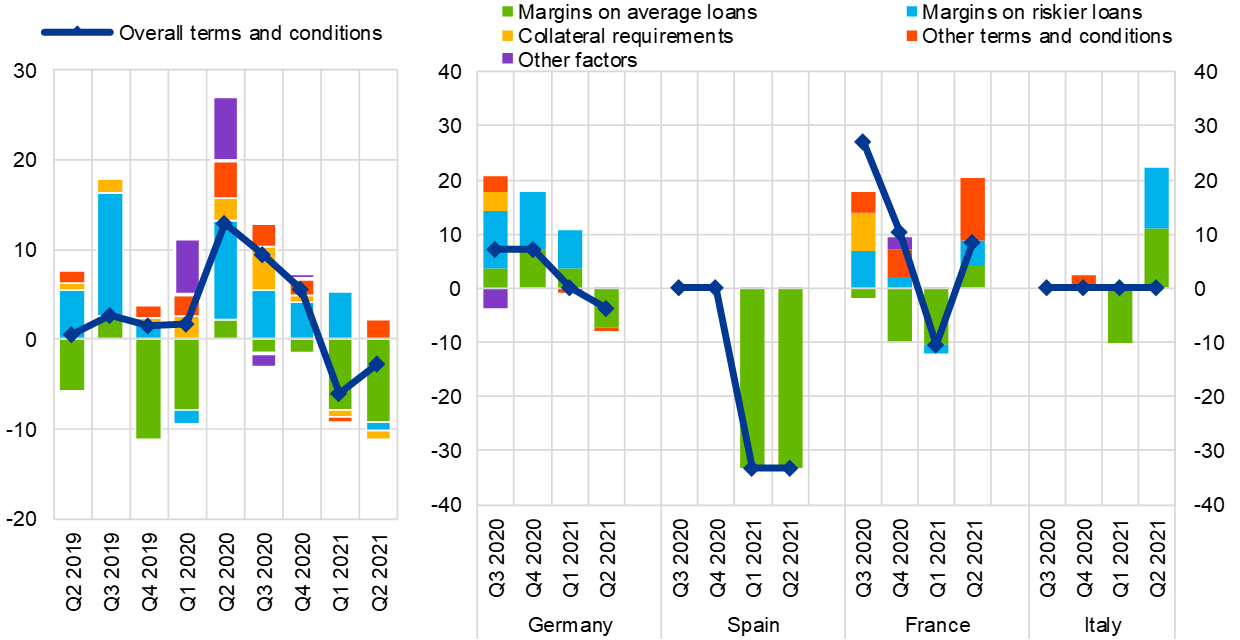
Notes: “Margins” are defined as the spread over a relevant market reference rate. “Other terms and conditions” is the unweighted average of “loan-to-value ratio”, “other loan size limits”, “non-interest rate charges” and “maturity”. The net percentages for “other factors” refer to further factors which were mentioned by banks as having contributed to changes in terms and conditions.
Table 6
Changes in terms and conditions on loans to households for house purchase
(net percentages of banks)

Note: See the notes on Chart 6.
Competitive pressures had a relevant net easing impact on banks’ overall terms and conditions for housing loans (see Table 7). By contrast, banks indicated that risk perceptions and their funding costs and balance sheet situations had a small net tightening impact.
Looking at the largest euro area countries, overall terms and conditions on housing loans eased in both Spain and, to a lesser extent, Germany. This was driven by a narrowing of margins on average loans, partly related to competitive pressures. In the case of Spain, this is consistent with the recent further decline in bank lending rates for house purchase, which have fallen to historical lows. By contrast, overall terms and conditions on housing loans tightened in France according to the banks, mainly owing to loan maturities, loan-to-value ratios and, to a lesser extent, a widening of margins on average and riskier loans. On balance, a lower risk tolerance of banks in France contributed to that development as did banks’ funding costs and balance sheet situations.
Table 7
Factors contributing to changes in overall terms and conditions on loans to households for house purchase
(net percentages of banks)

Note: The net percentages for these questions relating to contributing factors are defined as the difference between the percentage of banks reporting that the given factor contributed to a tightening and the percentage reporting that it contributed to an easing.
2.2.3 Rejection rate for housing loans increased
In the second quarter of 2021, euro area banks reported, on balance, an increase in the share of rejected applications for housing loans, which had been broadly stable in the previous quarter (net percentage of 11%, up from -1% in the previous quarter; see Chart 7).
Looking at the largest euro area countries, the rejection rate for housing loans increased in Germany, France and Italy, but remained unchanged in Spain. In France and Italy, high loan demand may have contributed to the increase in the rejection rate. And in France, banks’ lower risk tolerance may also have played a role.
Chart 7
Changes in the rejection rate for loans to households for house purchase
(net percentages of banks reporting an increase in the share of rejections)
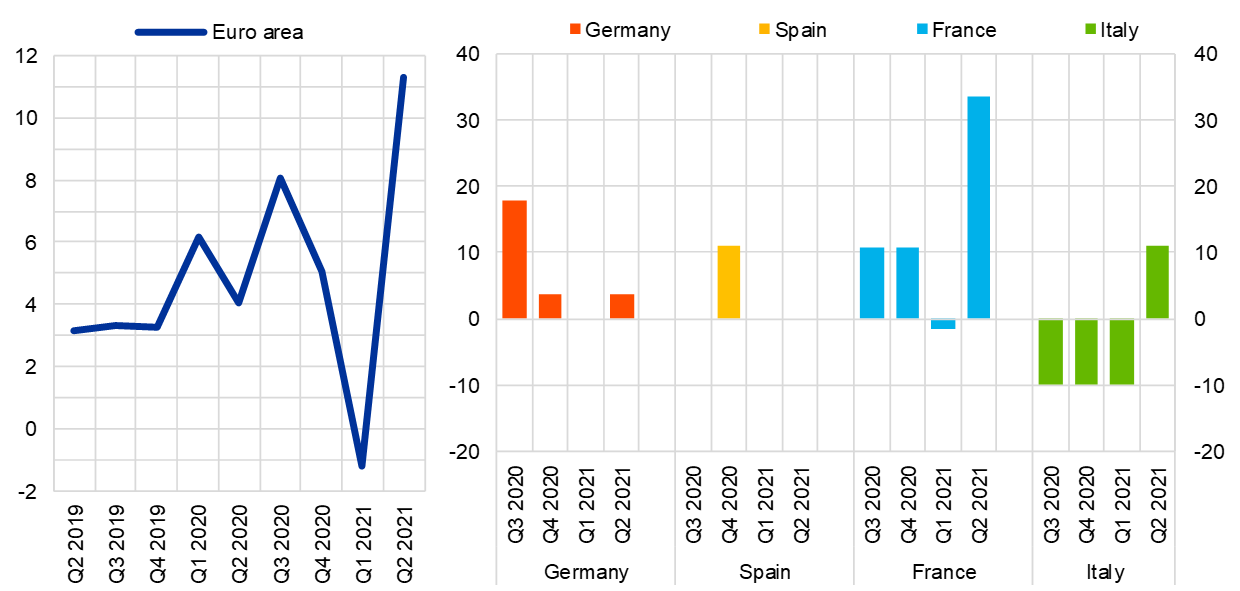
Notes: Net percentages for rejected loan applications are defined as the difference between the percentage of banks reporting an increase in the share of loan rejections and the percentage of banks reporting a decline. Banks’ answers refer to the share of rejected loan applications relative to the total volume of applications in that loan category.
2.2.4 Net demand for housing loans increased
Banks reported, in net terms, a strong increase in demand for housing loans in the second quarter of 2021 (net percentage of banks at 36%, up from -7% in the first quarter of 2021; see Chart 8 and overview table), thereby resuming the net increases in housing loan demand seen in the second half of 2020. This development is in line with the strong actual growth in loans to households for house purchase, given the broadly contemporaneous relationship between BLS demand and new housing loans.
Improving consumer confidence, favourable housing market prospects and the low general level of interest rates all contributed positively to strong housing loan demand, according to the banks (see Chart 8 and Table 8). This is consistent with the strong improvement in consumer confidence that was reported in the European Commission’s consumer sentiment survey in the second quarter. In addition, debt refinancing or restructuring of housing loans had a small positive impact on euro area housing loan demand, linked to the low interest rate environment. By contrast, households’ internal financing and loans from other banks had a small dampening impact on housing loan demand in the second quarter of 2021. The dampening impact of households’ internal finance of house purchase out of savings (by making larger down payments) appears consistent with the accumulation of household savings during the pandemic (which has moderated more recently).
Chart 8
Changes in demand for loans to households for house purchase, and contributing factors
(net percentages of banks reporting an increase in demand, and contributing factors)
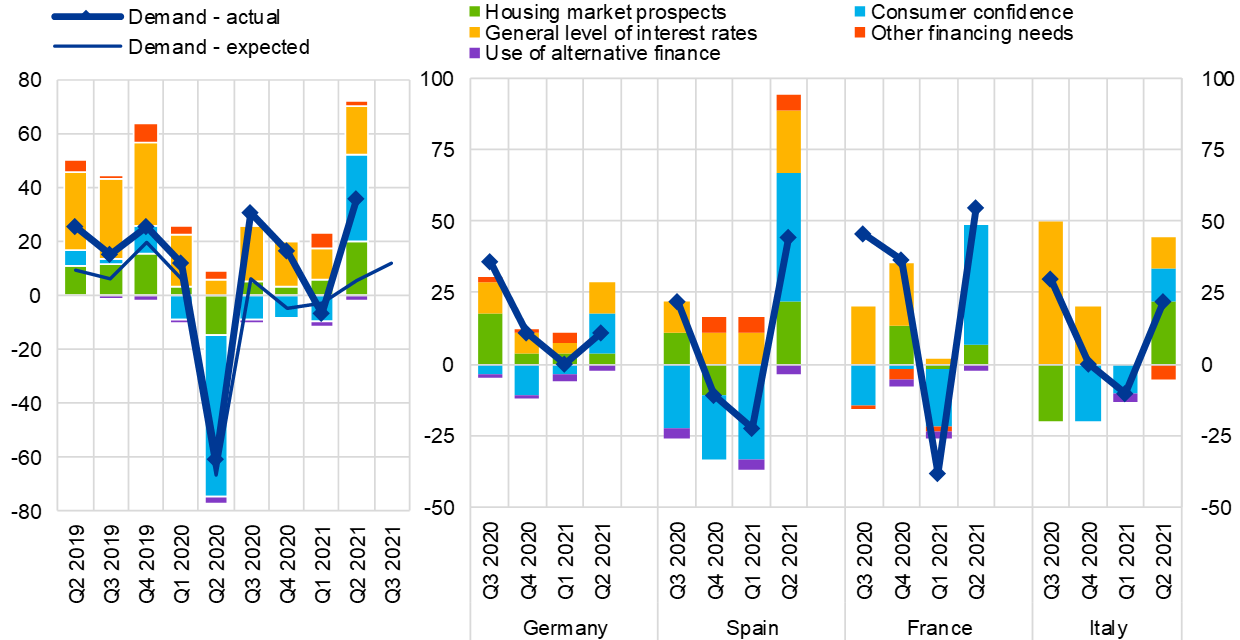
Notes: See the notes on Chart 4. “Other financing needs” is the unweighted average of “debt refinancing/restructuring and renegotiation” and “regulatory and fiscal regime of housing markets”; “use of alternative finance” is the unweighted average of “internal finance of house purchase out of savings/down payment”, “loans from other banks” and “other sources of external finance”.
In all of the largest euro area countries, banks reported a net increase in housing loan demand in the second quarter of 2021. Equally, in all of those countries, consumer confidence and favourable housing market prospects contributed to the net increase in housing loan demand, while the low general level of interest rates contributed to an increase in most countries. In Spain and, to a lesser extent, Germany, housing loan demand benefited from debt refinancing (leading to prolongation or higher loan amounts; included in “other financing needs”).
In the third quarter of 2021, banks expect a continued net increase in demand for housing loans (net percentage of banks at 12%).
Table 8
Factors contributing to changes in demand for loans to households for house purchase
(net percentages of banks)

Note: See the notes on Chart 8.
2.3 Consumer credit and other lending to households
2.3.1 Credit standards for consumer credit and other lending to households remained unchanged
In the second quarter of 2021, credit standards for consumer credit and other lending to households remained unchanged (net percentage of banks at 0%, down from 5% in the previous quarter; see Chart 9 and overview table), following moderate to strong net tightening in previous quarters. The last time that banks reported broadly unchanged credit standards was the third quarter of 2018.
Risk perceptions (mainly related to consumers’ creditworthiness) had a moderate net tightening impact on credit standards for consumer credit (see Chart 9 and Table 9), while banks’ risk tolerance had a moderate easing impact. Banks’ funding costs and balance sheet situations had a broadly neutral impact, as did competitive pressure from other banks and non-banks.
Looking at the largest euro area countries, credit standards for consumer credit and other lending to households eased significantly in Germany, supported by the easing impact of banks’ risk tolerance, risk perceptions and competitive pressure from other banks. Banks in Spain, France and Italy reported no changes to credit standards for consumer credit.
In the third quarter of 2021, euro area banks expect credit standards for consumer credit and other lending to households to remain broadly unchanged (net percentage of -1%).
Chart 9
Changes in credit standards applied to the approval of consumer credit and other lending to households, and contributing factors
(net percentages of banks reporting a tightening of credit standards, and contributing factors)
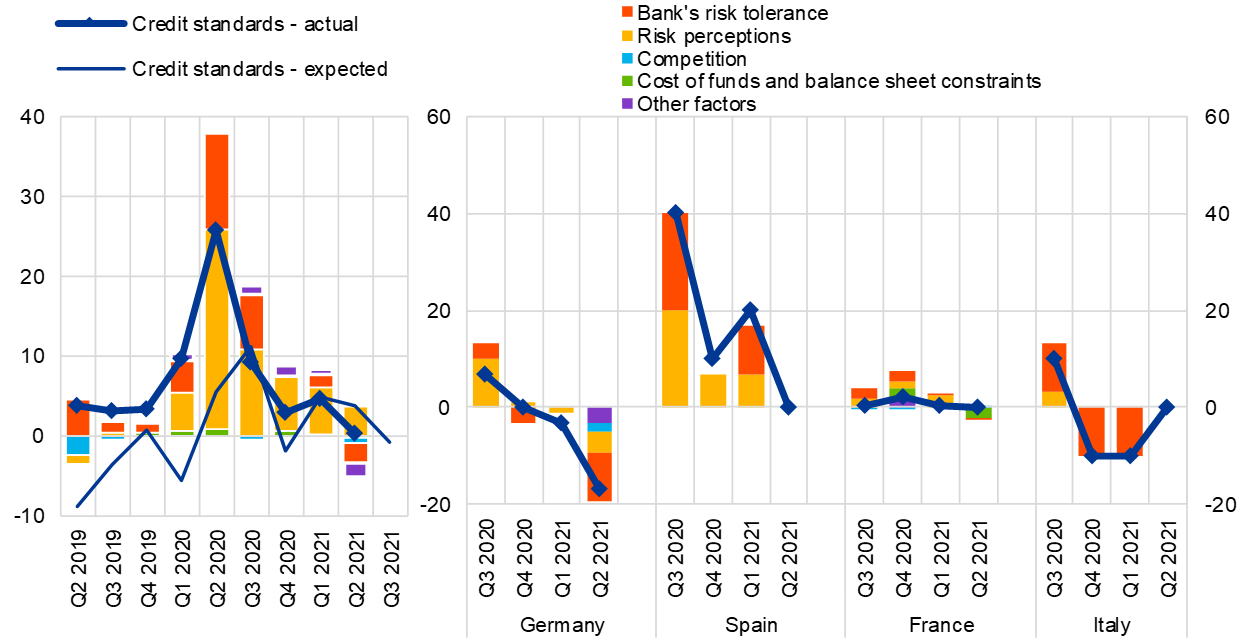
Notes: See the notes on Chart 1. “Risk perceptions” is the unweighted average of “general economic situation and outlook”, “creditworthiness of consumers” and “risk on the collateral demanded”; “competition” is the unweighted average of “competition from other banks” and “competition from non-banks”. The net percentages for “other factors” refer to further factors which were mentioned by banks as having contributed to changes in credit standards.
Table 9
Factors contributing to changes in credit standards for consumer credit and other lending to households
(net percentages of banks)

Note: See the notes on Chart 9.
2.3.2 Terms and conditions on consumer credit and other lending to households eased
In the second quarter of 2021, banks’ overall terms and conditions on consumer credit and other lending to households eased (net percentage of ‑6%, after 0% in the previous quarter; see Chart 10 and Table 10), supported by narrower margins on average loans and, to some extent, other terms and conditions (which mainly related to the size of loans).
Chart 10
Changes in terms and conditions on consumer credit and other lending to households
(net percentages of banks reporting a tightening of terms and conditions)

Notes: “Margins” are defined as the spread over a relevant market reference rate. “Other terms and conditions” is the unweighted average of “size of the loan”, “non-interest rate charges” and “maturity”. The net percentages for “other factors” refer to further factors which were mentioned by banks as having contributed to changes in terms and conditions.
Table 10
Changes in terms and conditions on consumer credit and other lending to households
(net percentages of banks)

Note: See the notes on Chart 10.
Pressure from competition had, on balance, an easing impact on banks’ overall terms and conditions for consumer credit. By contrast, risk perceptions, banks’ risk tolerance and banks’ cost of funds and balance sheet situations all had a broadly neutral impact (see Table 11).
Looking at the largest euro area countries, overall terms and conditions on consumer credit and other lending to households eased in Germany and Spain. In Germany, these developments were due to the easing impact of competition, risk perceptions and banks’ risk tolerance, whereas in Spain competitive pressure and banks’ funding costs and balance sheet situations had a net easing impact. Overall terms and conditions were unchanged in France and Italy in the second quarter.
Table 11
Factors contributing to changes in overall terms and conditions on consumer credit and other lending to households
(net percentages of banks)
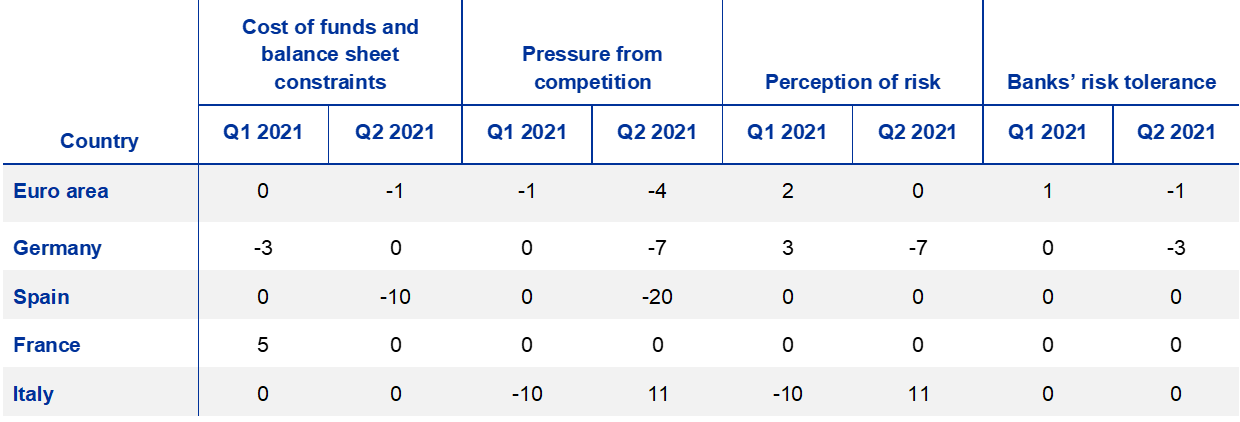
Note: The net percentages for these questions relating to contributing factors are defined as the difference between the percentage of banks reporting that the given factor contributed to a tightening and the percentage reporting that it contributed to an easing.
2.3.3 Rejection rate for consumer credit and other lending to households remained broadly unchanged
In the second quarter of 2021, euro area banks reported, on balance, that the share of rejected applications for consumer credit and other lending to households remained broadly unchanged (net percentage of 1%, down from 7% in the previous survey round; see Chart 11). This followed net increases in the share of loan rejections in previous quarters and was consistent with the unchanged credit standards for consumer credit and other lending to households.
Looking at the largest euro area countries, the rejection rate decreased moderately on balance in Germany, whereas it was broadly unchanged in Spain, France and Italy.
Chart 11
Changes in the rejection rate for consumer credit and other lending to households
(net percentages of banks reporting an increase in the share of rejections)

Notes: Net percentages for rejected loan applications are defined as the difference between the percentage of banks reporting an increase in the share of loan rejections and the percentage of banks reporting a decline. Banks’ responses refer to the share of rejected loan applications relative to the total volume of applications in that loan category.
2.3.4 Net demand for consumer credit and other lending to households increased
In the second quarter of 2021, banks reported, on balance, an increase in demand for consumer credit and other lending to households (net percentage of banks at 11%, up from -19%[11] in the previous quarter; see Chart 12 and overview table), which was above the historical average since 2003 (0%). This moderate increase in demand following net declines in the two previous quarters was broadly in line with the developments observed in actual consumer credit flows, reflecting the lifting of pandemic-related containment measures, although consumer credit remained subdued overall.
Banks reported that the rebound in consumer confidence, spending on durables and the low general level of interest rates all had a positive effect on demand for consumer credit (see Chart 12 and Table 12). These developments are in line with recent survey evidence on improving consumer confidence in the euro area.
Chart 12
Changes in demand for consumer credit and other lending to households, and contributing factors
(net percentages of banks reporting an increase in demand, and contributing factors)

Notes: See the notes on Chart 4. “Use of alternative finance” is the unweighted average of “internal financing out of savings”, “loans from other banks” and “other sources of external finance”. “Consumption exp. (real estate)” denotes “consumption expenditure financed through real estate-guaranteed loans”.
Looking at the largest euro area countries, banks in Germany, Spain and Italy reported a net increase in demand for consumer credit. Higher consumer confidence, increased spending on durable goods and the low general level of interest rates were the most important factors explaining the net increase in these countries. At the same time, similar to the previous quarter, banks in France continued to report a net decline in demand for consumer credit, driven mainly by spending on durable goods and household savings.
In the third quarter of 2021, banks expect a strong net increase in demand for consumer credit and other lending to households (net percentage of 31%).
Table 12
Factors contributing to changes in demand for consumer credit and other lending to households
(net percentages of banks)

Note: See the notes on Chart 12.
3 Ad hoc questions
3.1 Banks’ access to retail and wholesale funding
The July 2021 survey included a question on the extent to which the situation in financial markets had affected banks’ access to retail and wholesale funding. Banks were asked whether their access to funding had deteriorated or eased over the past three months, as well as what their expectations were for the next three months. Here, negative net percentages indicate an improvement, while positive figures indicate a deterioration in net terms.
Chart 13
Banks’ assessment of funding conditions and the ability to transfer credit risk off the balance sheet
(net percentages of banks reporting a deterioration in market access)
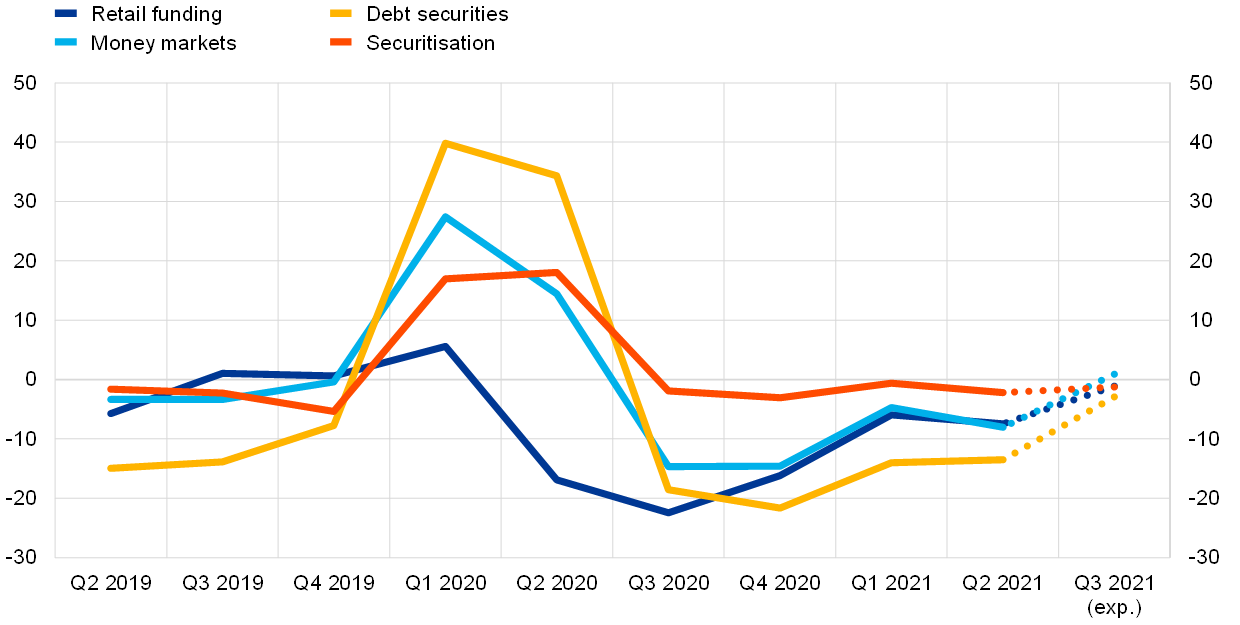
Note: The net percentages are defined as the difference between the sum of the percentages for “deteriorated considerably” and “deteriorated somewhat” and the sum of the percentages for “eased somewhat” and “eased considerably”.
Table 13
Banks’ assessment of funding conditions and the ability to transfer credit risk off the balance sheet
(net percentages of banks reporting a deterioration in market access)

Note: See the notes on Chart 13.
In the second quarter of 2021, euro area banks reported, in net terms, that their access to retail and wholesale funding had continued to improve (see Chart 13 and Table 13). Access to money markets and funding via debt securities (particularly medium and long-term securities) continued to improve on balance at levels similar to those seen in the previous quarter. In addition, access to securitisation also improved slightly in the second quarter of 2021.[12] This indicates that, thanks to supportive monetary and supervisory policy actions, access to funding remained favourable for banks despite the general rise in longer-term risk-free rates in the first half of 2021. Access to retail funding also continued to improve to a similar extent as in the first quarter of 2021, for both short-term and long-term deposits. The improvement was again driven by short-term deposit funding but remained limited compared with the first few quarters of the pandemic, which probably reflects firm and household deposit flows returning to pre-pandemic levels in the second quarter of 2021 owing to the improving economic situation.
Looking ahead to the third quarter of 2021, euro area banks expect their access to debt securities funding to continue to improve moderately, while they expect access to other funding sources to remain broadly unchanged.
3.2 The impact of banks’ NPL ratios on their lending policies
The July 2021 survey also included a biannual ad hoc question about the impact that banks’ NPL ratios have on their lending policies and the factors through which NPL ratios contribute to changes in lending policies. Banks were asked about the impact on loans to enterprises, loans to households for house purchase, and consumer credit and other lending to households over the past six months and the next six months.
Euro area banks reported, on balance, that their NPL ratios had a moderate tightening impact on credit standards for loans to enterprises (net percentage of 5%, down from 15% in the second half of 2020; see Chart 14) and a broadly neutral impact on credit standards for loans to households in the first half of 2021 (0% and 1% for housing loans and consumer credit respectively). This followed a stronger net tightening impact in the second half of 2020 for loans to firms and consumer credit. Similarly, banks reported that their NPL ratios had a smaller net tightening impact on terms and conditions for loans to firms than in the previous round (net percentage of 3%, down from 9%) and a neutral impact on terms and conditions for loans to households over the past six months (0% for both housing loans and consumer credit; see Chart 14). The reported tightening impact of banks’ NPL ratios on their lending conditions was smaller than the expectations expressed in the previous round across all categories, which probably reflects the continued decline in banks’ NPL ratios in recent quarters (which has largely been due to further sales of legacy exposures).
In the first half of 2021, euro area banks continued to refer mainly to higher risk perceptions related to the general economic outlook and borrowers’ creditworthiness and to lower risk tolerance as factors contributing to NPL ratios’ net tightening impact on lending conditions (see Chart 15). In addition, costs related to balance sheet clean-up operations contributed slightly to a net tightening, while banks’ capital costs had a moderate easing impact on banks’ lending policies via NPL ratios. Supervisory or regulatory requirements, banks’ liquidity positions and access to market financing all had a neutral impact on lending conditions via NPL ratios.
Chart 14
Impact of banks’ NPL ratios on credit standards and terms and conditions
(net percentages of banks)

Notes: The NPL ratio is defined as the stock of gross NPLs on a bank’s balance sheet as a percentage of the gross carrying amount of loans. Changes in credit standards and/or terms and conditions can be caused by changes to the NPL ratio or by changes to regulations or the bank’s assessment of the level of the NPL ratio. Net percentages are defined as the difference between the sum of the percentages for “contributed considerably to tightening” and “contributed somewhat to tightening” and the sum of the percentages for “contributed somewhat to easing” and “contributed considerably to easing”. The diamonds denote expectations indicated by banks in the current round.
Chart 15
Contributions of factors through which NPL ratios affect banks’ policies on lending to enterprises and households
(net percentages of banks)
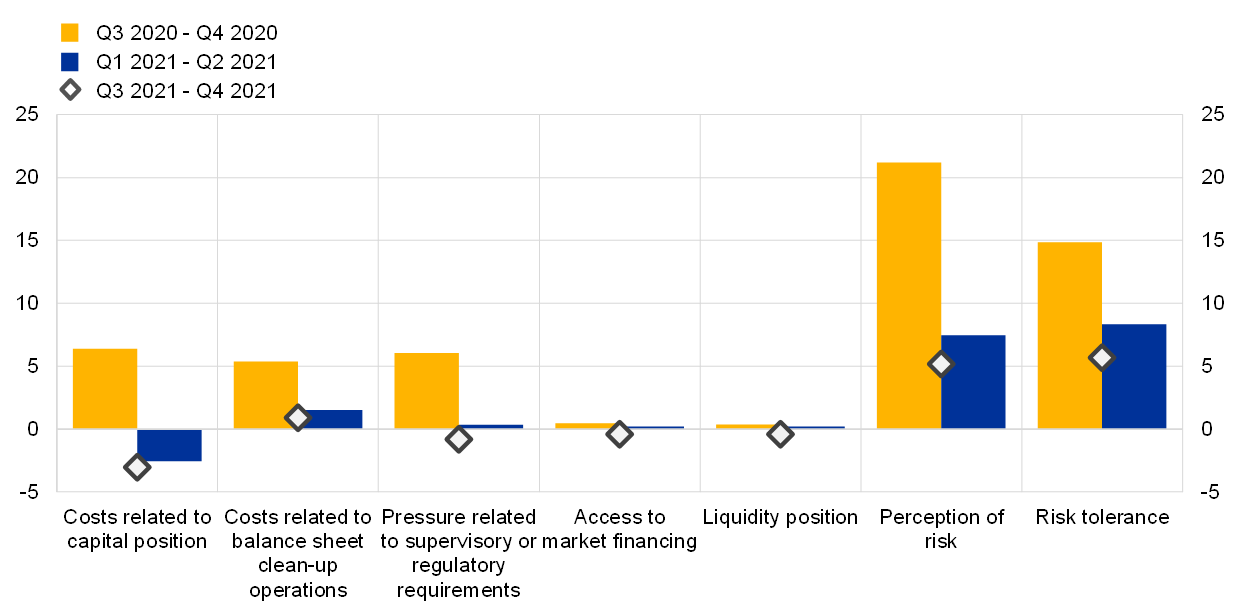
Note: See the notes on Chart 14.
Over the next six months, euro area banks expect NPL ratios to have a slight net tightening impact on lending conditions for loans to firms and a broadly neutral impact on loans to households. Higher risk perceptions and lower risk tolerance are expected to contribute to another moderate net tightening of lending policies, with net percentages remaining at levels similar to those seen over the past six months. By contrast, banks’ capital costs are expected to continue to have an easing impact over the next six months. Overall, this suggests that banks do not foresee an increase in their NPL ratios that is severe enough to considerably affect their lending conditions, despite remaining uncertainty about the latent credit risks of their borrowers.
3.3 Bank lending conditions and loan demand across main economic sectors
The July 2021 survey questionnaire also included a biannual ad hoc question aimed at collecting information on changes in banks’ credit standards, overall terms and conditions and loan demand across the main sectors of economic activities over the past six months and the next six months. Banks were asked to collect information covering the following sectors: manufacturing, construction (excluding real estate), services (excluding financial services and real estate), wholesale and retail trade, and real estate (including both real estate construction and real estate services, broken down into commercial and residential real estate).
Euro area banks reported a moderate net tightening of credit standards and terms and conditions for new loans to enterprises in most of the main economic sectors in the first half of 2021 (see Charts 16 and 17). The net tightening of credit standards was in line with the moderate net tightening reported by banks for loans to all firms in the first quarter of 2021 and the broadly unchanged credit standards reported in the second quarter. It was most pronounced for loans to firms in the wholesale and retail trade sector (net percentage of 10%, down from 24% in the second half of 2020) and the services sector (6%, down from 20%), which continued to be more strongly affected by lockdown measures in the first half of 2021. By contrast, the net tightening of credit standards was more contained for the commercial real estate (4%), construction (4%) and manufacturing (3%) sectors. Only for the residential real estate sector did banks report broadly unchanged credit standards and a slight net easing of terms and conditions. Across all sectors, the net tightening of credit standards reported by banks for the first half of 2021 was smaller than that seen in the second half of 2020, in line with the declining net percentages observed for credit standards on loans to all firms in the two most recent quarters, reflecting the overall improvements in the economic situation (see Section 2.1). At the same time, the net tightening remained stronger in the sectors that were more affected by containment measures.
Over the next six months, euro area banks expect credit standards on new loans to enterprises to remain broadly unchanged in most of the main economic sectors. For services, they expect a slight net easing, reflecting the sector’s recovery following the lifting of the containment measures. And for commercial real estate, they expect a further moderate tightening. As regards overall terms and conditions on new loans to firms in the second half of 2021, banks expect a net easing in the manufacturing, services and residential real estate sectors, and a net tightening in the construction and commercial real estate sectors.
Chart 16
Changes in credit standards for new loans to enterprises across main economic sectors
(net percentages of banks; over the past six months and the next six months)
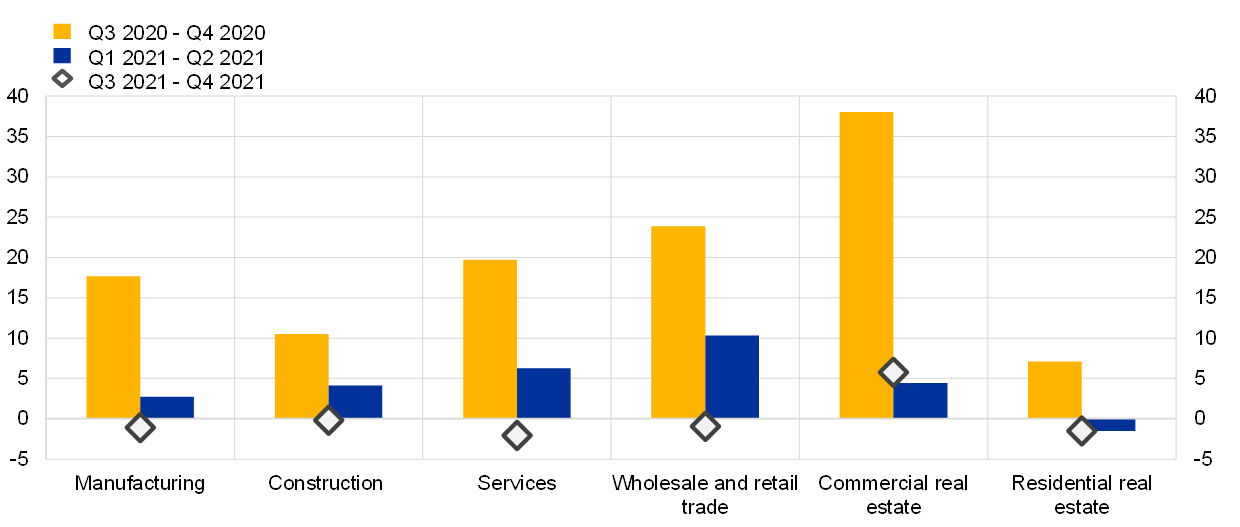
Notes: The net percentages refer to the difference between the sum of the percentages for “deteriorated considerably” and “deteriorated somewhat” and the sum of the percentages for “eased somewhat” and “eased considerably". The diamonds denote expectations indicated by banks in the current round.
Chart 17
Changes in terms and conditions for new loans to enterprises across main economic sectors
(net percentages of banks; over the past six months and the next six months)

Note: See the notes on Chart 16.
Banks reported, on balance, an increase in demand for loans or credit lines in all economic sectors, with the exception of the commercial real estate sector, where net demand remained unchanged in the first half of 2021 (see Chart 18). The net increase in demand was most pronounced in the residential real estate sector, in line with households’ strong demand for housing loans in the second quarter of 2021 (see Section 2.2).
Over the next six months, euro area banks expect a further net increase in loan demand in all of the main economic sectors.
Chart 18
Changes in demand for loans or credit lines to enterprises across main economic sectors
(net percentages of banks)
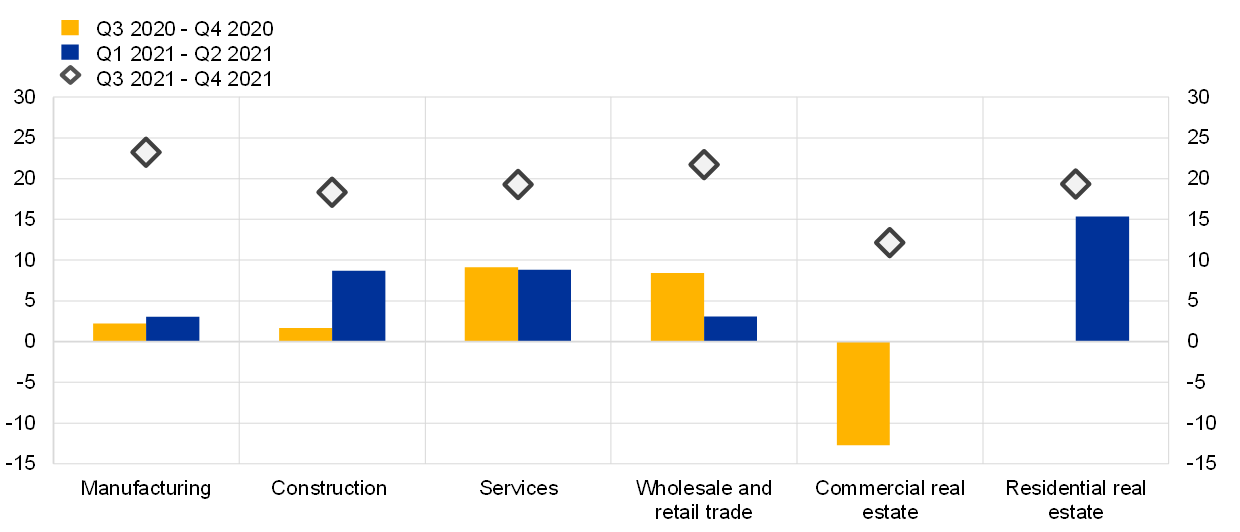
Notes: The net percentages refer to the difference between the sum of the percentages for “increased considerably” and “increased somewhat” and the sum of the percentages for “decreased somewhat” and “decreased considerably". The diamonds denote expectations indicated by banks in the current round.
3.4 The impact of government loan guarantees related to the coronavirus pandemic
The July 2021 survey questionnaire also included a biannual ad hoc question aimed at collecting information on changes in lending conditions and demand for loans with and without COVID-19-related government guarantees over the past six months and the next six months. In addition, the question also asked about the factors affecting demand for loans with COVID-19-related government guarantees.
Euro area banks reported that COVID-19-related government guarantees continued to support banks’ credit standards for loans to firms in the first half of 2021 (see Chart 19). Credit standards for loans to firms with COVID-19-related government guarantees continued to ease in the first half of 2021 (net percentage of -10%, after -18% in the second half of 2020). Similar net easing was reported for loans to SMEs (-9%, after -16%) and loans to large enterprises (-7%, after -17%). For loans to enterprises without government guarantees, banks reported, on balance, that credit standards were unchanged in the first half of 2021 (net percentage of 0%, down from 16% in the second half of 2020; see Chart 19). This reflected unchanged credit standards for loans to SMEs (0%) and a small net easing for loans to large enterprises (-3%), implicitly suggesting that SMEs benefit particularly from the guarantees. As the take-up of loans with government guarantees became relatively small in the first half of 2021, developments in credit standards for all bank loans to firms were dominated by loans without public guarantees.
In the second half of 2021, euro area banks expect only a slight further net easing of their credit standards for loans with government guarantees, both for SMEs (-2%) and for large enterprises (-2%). For loans without guarantees, banks expect credit standards to remain broadly unchanged across firm sizes over the next six months.
Chart 19
Changes in credit standards for loans to enterprises with and without COVID-19-related government guarantees
(net percentages of banks)

Notes: The net percentages refer to the difference between the sum of the percentages for “tightened considerably” and “tightened somewhat” and the sum of the percentages for “eased somewhat” and “eased considerably". The diamonds denote expectations indicated by banks in the current round.
Chart 20
Changes in terms and conditions for loans to enterprises with and without COVID-19-related government guarantees
(net percentages of banks)

Notes: The net percentages refer to the difference between the sum of the percentages for “tightened considerably” and “tightened somewhat” and the sum of the percentages for “eased somewhat” and “eased considerably". The diamonds denote expectations indicated by banks in the current round.
Banks’ terms and conditions eased in net terms for loans to firms with and without COVID-19-related government guarantees in the first half of 2021 (-6%, after -14%, for loans with guarantees; and -5%, after 9%, for loans without guarantees; see Chart 20), in line with the net easing reported for the second quarter of 2021 for all loans (which followed broadly unchanged terms and conditions in the first quarter; see Section 2.1). For loans with guarantees, a similar net easing was seen for loans to SMEs and large enterprises, while for loans without guarantees, terms and conditions remained broadly unchanged for SMEs and only eased for large firms.
Over the next six months, banks expect their terms and conditions to continue to ease, both for loans with guarantees (-5%) and for loans without guarantees (-2%).
In the first half of 2021, banks reported, on balance, a decline in demand for loans with COVID-19-related government guarantees (with the net percentage of banks reporting an increase in loan demand standing at -26%, down from 4% in the second half of 2020; see Chart 21). Similar net declines were reported for loan demand by SMEs (-26%) and large enterprises (-30%), reflecting the moderation of actual loan flows to firms in general and, in particular, the large take-up of guaranteed loans in 2020. Banks also reported a moderate decline in net demand for loans without guarantees in the first half of 2021 (net percentage of -6%, after -6%; see Chart 21). This is in line with overall loan demand by firms declining in the first quarter of 2021 and increasing moderately in the second quarter of 2021 (see Section 2.1).
Chart 21
Changes in demand for loans to enterprises with and without COVID-19-related government guarantees
(net percentages of banks)

Notes: The net percentages refer to the difference between the sum of the percentages for “increased considerably” and “increased somewhat” and the sum of the percentages for “decreased somewhat” and “decreased considerably". The diamonds denote expectations indicated by banks in the current round.
Over the next six months, euro area banks expect a further net decline in demand for loans with guarantees, but a net increase in demand for loans without guarantees, as the economic recovery progresses.
In the first half of 2021, precautionary liquidity needs, fixed investment and loan substitution all contributed to the net decline in demand for loans with COVID-19‑related guarantees (see Chart 22), while acute liquidity needs had a broadly neutral impact on loan demand. The fact that liquidity needs had a smaller impact on demand for guaranteed loans compared with 2020 is consistent with firms’ liquidity buffers being sufficient and revenues probably improving as the economic recovery picks up. In addition, it confirms the interpretation that the neutral impact of working capital and inventories on overall loan demand in the last two quarters reflects reduced liquidity needs (see Section 2.1).
Over the next six months, banks expect liquidity needs and loan substitution to continue to have a small negative impact on demand for loans with government guarantees, while fixed investment is expected to have a neutral impact on firms’ demand for guaranteed loans.
Chart 22
Factors affecting demand for loans or credit lines with COVID-19-related government guarantees
(net percentages of banks)
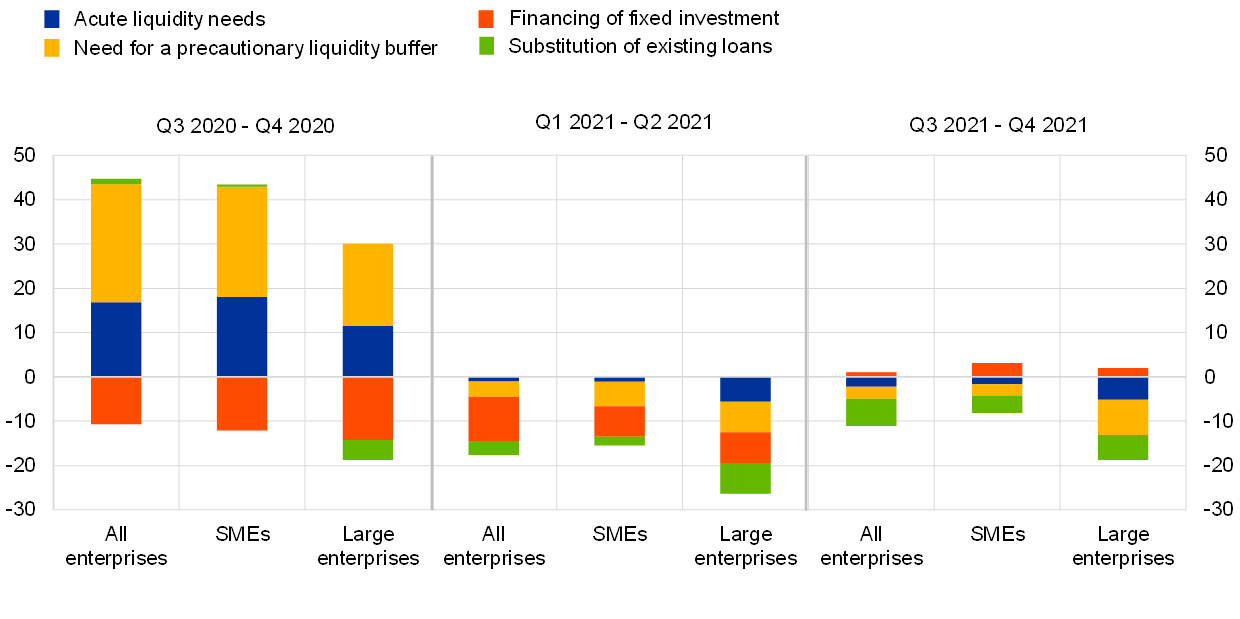
Notes: The net percentages refer to the difference between the sum of the percentages for “increased considerably” and “increased somewhat” and the sum of the percentages for “decreased somewhat” and “decreased considerably". Banks can select more than one factor that affects loan demand. Therefore, the sum of the net percentages can exceed 100 in this chart. The last period denotes expectations indicated by banks in the current round.
Annexes
See more.
© European Central Bank, 2021
Postal address 60640 Frankfurt am Main, Germany
Telephone +49 69 1344 0
Website www.ecb.europa.eu
All rights reserved. Reproduction for educational and non-commercial purposes is permitted provided that the source is acknowledged.
For specific terminology please refer to the ECB glossary (available in English only).
PDF ISSN 1830-5989, QB-BA-21-003-EN-N
HTML ISSN 1830-5989, QB-BA-21-003-EN-Q
- The four largest euro area countries in terms of GDP are Germany, France, Italy and Spain.
- This result also holds, tentatively, for SMEs. According to the most recent Survey on the Access to Finance of Enterprises (SAFE), euro area SMEs have tended, on balance, to report smaller declines in fixed investment.
- For more detailed information on the bank lending survey, see the article entitled “A bank lending survey for the euro area”, Monthly Bulletin, ECB, April 2003; Köhler-Ulbrich, P., Hempell, H. and Scopel, S., “The euro area bank lending survey”, Occasional Paper Series, No 179, ECB, 2016; and Burlon, L., Dimou, M., Drahonsky, A. and Köhler-Ulbrich, P., “What does the bank lending survey tell us about credit conditions for euro area firms?”, Economic Bulletin, Issue 8, ECB, December 2019.
- In this case, the selected sample banks are generally of similar size or their lending behaviour is typical of a larger group of banks.
- The non-harmonised historical data differ from the harmonised data mainly as a result of heterogeneous treatment of “NA” (Not Applicable) replies and specialised banks across questions and countries. Non-harmonised historical BLS data are published for discontinued BLS questions and ad hoc questions.
- The net tightening of credit standards for loans to euro area firms was 19% in the third quarter of 2020 and 18% in the fourth quarter of 2020 (revised downwards from 25% owing to revisions in one country).
- Meanwhile, banks in the Netherlands reported a considerable net decrease in the share of loan rejections.
- The euro area’s net percentage for the first quarter of 2021 was revised upwards from -20% owing to revisions in one country.
- This result also holds, tentatively, for SMEs. According to the most recent SAFE survey, euro area SMEs have tended, on balance, to report smaller declines in fixed investment.
- The calculation of simple averages when combining factors in larger categories assumes that all factors have the same importance for the banks. This partly explains some inconsistencies between developments in demand for loans and developments in the main underlying factors.
- This figure for the first quarter of 2021 was revised upwards from -24% owing to revisions in one country.
- For the results on securitisation, a large number of banks replied “not applicable”, as this source of funding is not relevant for them (between 47% and 60%, depending on the type of securitisation).
- 20 July 2021


